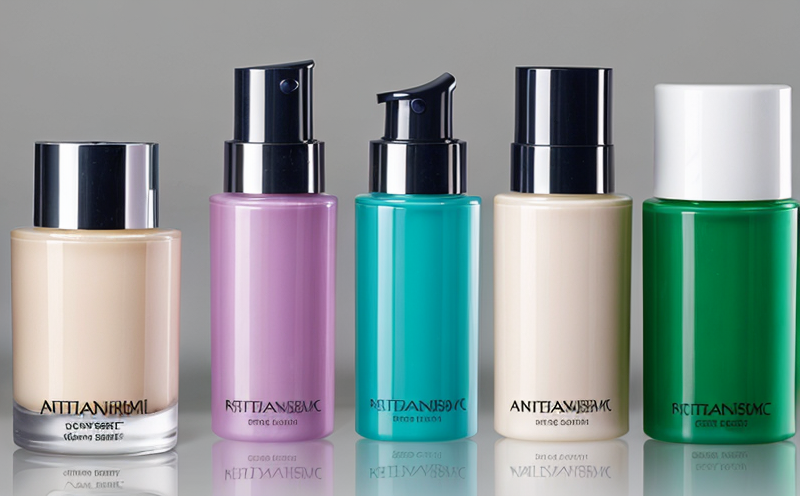Antimicrobial Effectiveness Testing in Herbal Cosmetics
In the rapidly evolving world of cosmetics, ensuring the safety and efficacy of products is paramount. Among the critical factors are preservatives and antimicrobials that prevent contamination and maintain product stability over time. This article focuses on antimicrobial effectiveness testing in herbal cosmetics, a crucial aspect of quality assurance for manufacturers.
The testing process involves evaluating the ability of preservatives to inhibit or kill microorganisms such as bacteria, fungi, and yeasts present in cosmetic products. The efficacy of these antimicrobial agents is tested against specific microbial strains that are known to cause spoilage or contamination. This ensures that the product remains safe for use and meets regulatory standards.
Herbal cosmetics pose unique challenges due to their complex ingredients derived from natural sources. These ingredients can vary widely in composition, which necessitates a comprehensive understanding of how they interact with preservatives. The testing protocols must account for these variables to ensure accurate and reliable results.
The testing process typically involves the following steps:
- Selection of appropriate microbial strains
- Preparation of the cosmetic sample
- Application of the preservative under controlled conditions
- Observation and measurement of antimicrobial activity over time
- Data analysis to determine efficacy levels
The primary instruments used in this testing include bioreactors for controlled microbial growth, UV spectrophotometers for measuring changes in product composition, and electronic noses or gas chromatography-mass spectrometry (GC-MS) to analyze volatile organic compounds released during the testing process.
The acceptance criteria are based on international standards such as ISO 22196:2011, which outlines methods for determining antimicrobial activity. Compliance with these standards ensures that the test results are comparable and internationally recognized.
In conclusion, antimicrobial effectiveness testing in herbal cosmetics is a vital component of ensuring product safety and quality. It provides manufacturers with critical data to optimize their formulations and meet regulatory requirements. This testing process not only enhances consumer confidence but also contributes to the overall safety and efficacy of cosmetic products.
Why Choose This Test
Selecting the right antimicrobial preservatives for herbal cosmetics is essential to ensure product stability and safety. The following factors highlight why this testing is crucial:
- Regulatory Compliance: Many countries have stringent regulations regarding the use of preservatives in cosmetics. Testing ensures compliance with these standards.
- Safety Assurance: Proper testing minimizes the risk of microbial contamination, which can lead to severe health issues for consumers.
- Innovation: Effective antimicrobial agents allow manufacturers to develop new and improved formulas without compromising safety.
- Certification: Positive test results contribute to the certification process, enhancing product reputation and marketability.
The testing process is rigorous and involves multiple stages. First, the sample preparation ensures accurate representation of the cosmetic formulation. Then, microbial strains are selected based on their relevance to potential contaminants in herbal cosmetics. The preservative is applied under controlled conditions to observe its effectiveness against these microorganisms. Finally, data analysis provides insights into the efficacy levels.
By choosing this test, manufacturers can gain valuable insights into the performance of different preservatives and antimicrobial agents. This information is crucial for optimizing product formulations and ensuring long-term stability. Additionally, it helps in identifying any potential risks associated with specific ingredients or formulations.
International Acceptance and Recognition
The antimicrobial effectiveness testing in herbal cosmetics follows internationally recognized standards such as ISO 22196:2011, which sets the benchmark for antimicrobial activity determination. This standard ensures that tests are conducted under standardized conditions, making results comparable across different laboratories and jurisdictions.
International acceptance of these test results is crucial for global market entry. Many countries have harmonized their regulations with international standards to ensure product safety and efficacy. Compliance with ISO 22196:2011 facilitates easier export and import processes, reducing compliance costs for manufacturers.
The recognition of these tests extends beyond regulatory compliance; it also enhances consumer trust in the brand's commitment to quality and safety. This is particularly important in the cosmetics industry, where consumers are increasingly concerned about the ingredients used in their products. Positive test results can significantly boost a brand's reputation and market standing.
Moreover, international acceptance of these tests ensures that manufacturers meet global standards for product safety and efficacy. This not only facilitates easier market entry but also helps in building a strong foothold in competitive markets. By adhering to these internationally recognized standards, manufacturers demonstrate their commitment to excellence and reliability.
Environmental and Sustainability Contributions
The antimicrobial effectiveness testing in herbal cosmetics contributes significantly to environmental sustainability by promoting the use of eco-friendly preservatives. The increasing trend towards sustainable practices has led to a shift towards natural and biodegradable preservatives, which are less harmful to the environment compared to synthetic alternatives.
This testing process helps identify the most effective natural preservatives that can be used in herbal cosmetics without compromising product stability or safety. By selecting the right antimicrobial agents, manufacturers can reduce their environmental footprint while maintaining high-quality standards. This approach not only supports sustainable practices but also aligns with consumer preferences for eco-friendly products.
The testing process itself is designed to minimize waste and energy consumption. For instance, bioreactors used in the testing process are optimized to use minimal resources, ensuring efficient and effective testing without excessive environmental impact. Additionally, the use of electronic noses or GC-MS instruments reduces the need for large-scale laboratory setups, further contributing to sustainability.
By embracing these sustainable practices, manufacturers can contribute positively to environmental conservation efforts. This not only enhances their corporate social responsibility (CSR) profile but also fosters a positive brand image among environmentally conscious consumers. In conclusion, antimicrobial effectiveness testing in herbal cosmetics plays a vital role in promoting sustainability and eco-friendly practices in the cosmetics industry.





